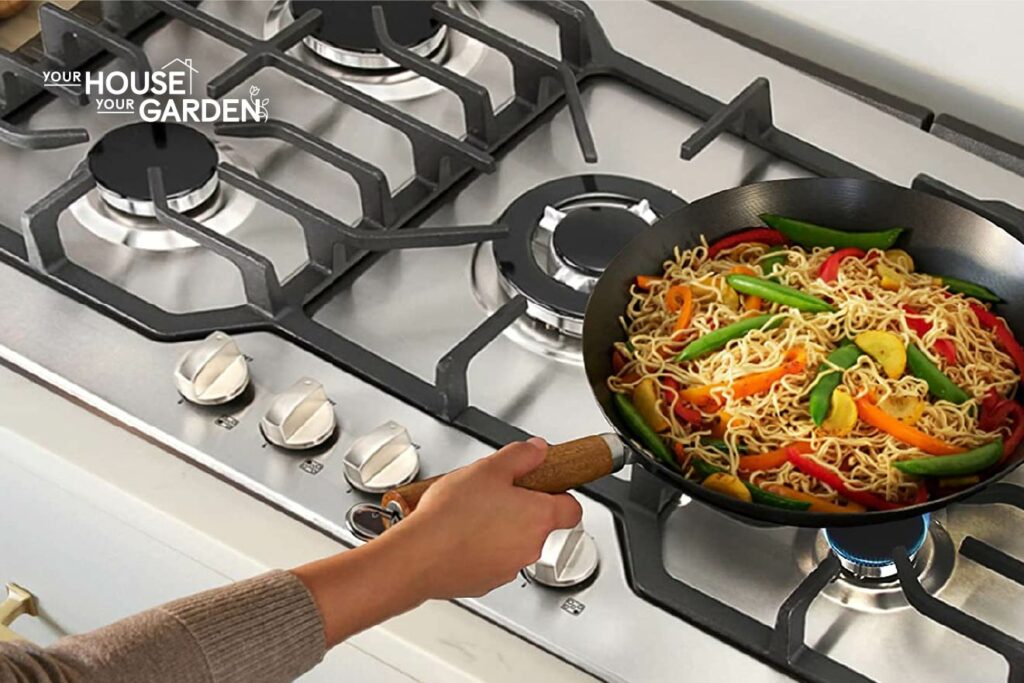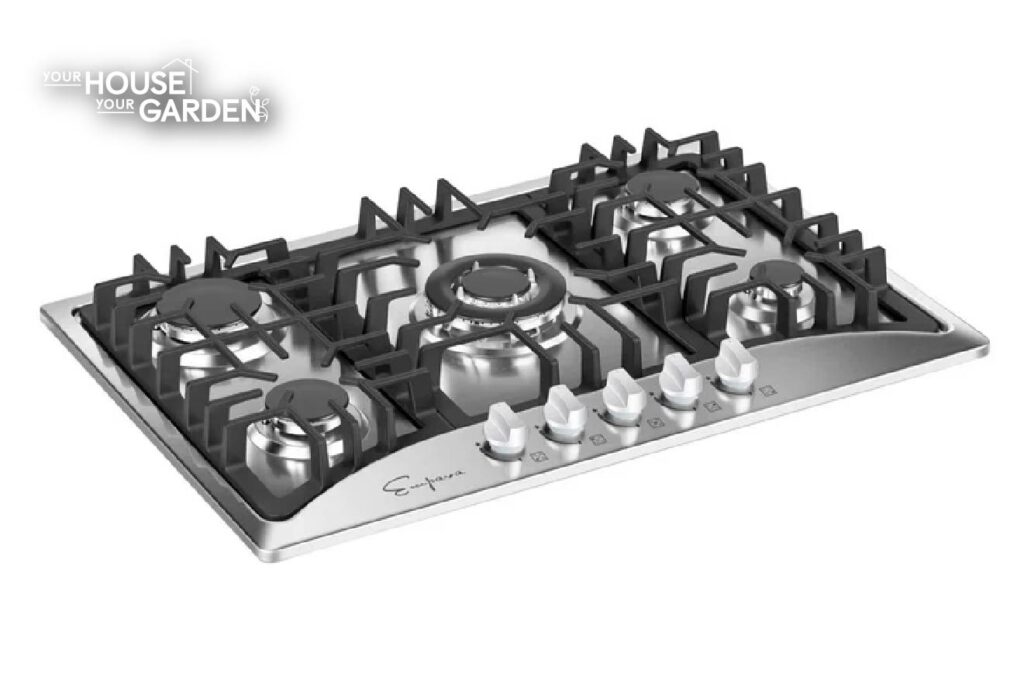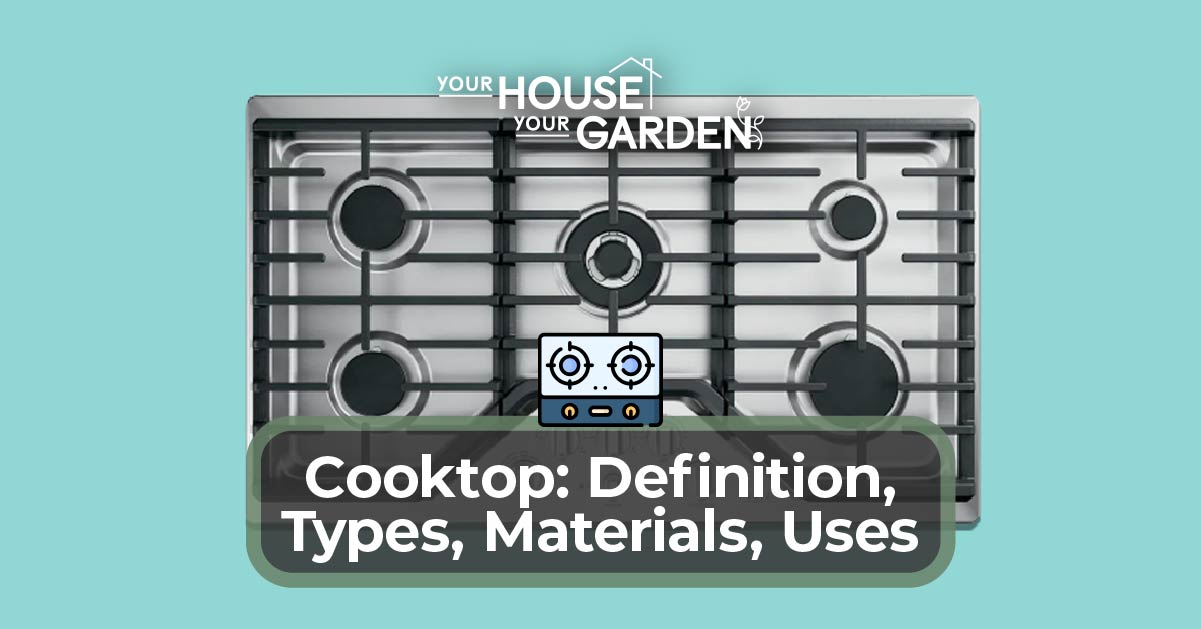A cooktop is a large appliance used to cook foods. A cooktop refers to the flat top surface of a cooking range. A cooktop may be electric, gas, or induction.
Electric cooktops are more modern and found in newer kitchens. Electric cooktops may cost more but also last longer than gas cooktops. The average size of a cooktop is between 30-36 inches in size. It’s important to choose a cooktop that is compatible with your household hookup type and that fits your kitchen space.
Directly below the cooktop is an oven. The cooktop and oven together are called a range. A cooktop can be standalone or built into the counter. The primary purpose of a cooktop is to heat foods. This may be done using a pan or pot that sits directly on top of the cooktop.
The preferred type of cooktop is a stainless steel cooktop. Cooktops are also available in porcelain, ceramic, or glass. Stainless steel cooktops last the longest and are easier to clean.
The history of cooktops dates back over 4,000 years. The first cooktop was simple and included a flat top that sat over top of a fire.
Materials for Cooktop
The best material for a cooktop is stainless steel. Stainless steel cooktops cost more than other types of cooktops, like glass or ceramic, but last longer. Stainless steel cooktops are also easier to maintain and clean, which can lead to a longer lifespan. Stainless steel cooktops may also lead to more consistent heating, which means they’re less likely to burn food.
Gas cooktops can reach higher temperatures and are often preferred by home chefs. Gas cooktops also heat up faster than electric cooktops. Induction cooktops are cooktops that use an electromagnetic heat source that offers consistent, fast heating. Induction cooktops require specific cookware.
Gas cooktops may be cheaper than electric cooktops, but don’t last as long. Some people consider electric cooktops to be safer because they don’t have an open flame. If you’re concerned about environmental health risks, a stainless steel electric cooktop is the best option because there’s no chance of gas leaking from the cooktop.
Types of Cooktop
The types of cooktops include:
- Gas cooktops: A gas cooktop uses gas power to heat coils.
- Electric cooktops: An electric cooktop uses electricity to heat the flat top.
- Induction cooktops: Induction cooktops use electromagnetic energy to heat.
- Rangetops: A range top is a drop-in unit that slides into your countertop.
Sizes of Cooktop
Cooktops range in size from 30-36 inches. The best cooktop size for you depends on your household cooking needs and the size of your kitchen. Smaller cooktops may have fewer burners and may be better suited for smaller households. Households with more than four people may want a larger cooktop with more than four burners.
Commercial-sized cooktops have even more burners and are better suited for cooking multiple dishes at one time. The size of your oven may also determine the best size for the cooktop. If you buy the cooktop and oven separately, you’ll want a cooktop that fits appropriately over top of the oven.
Does Size Affect Cooktop’s Usage?
Size can affect the number of dishes you can make at one time. If you use pots or pans that are too large for the size of the cooktop burners, it can take longer to heat and lead to inconsistency. The size of the cooktop can also affect the number of pots or pans you can use at one time. A cooktop with four burners in a smaller size may mean you have to use smaller pots if using all four burners.

Use Cases of Cooktop
A use case of a cooktop refers to the ways in which you can use it to heat ingredients or cook foods. A few use cases of cooktops include:
- Fry foods, like steaks and fish
- Boil water for pasta
- Cook meats, like hamburgers and hotdogs
- Grill vegetables, like asparagus and tomatoes
Once you learn how to use a cooktop, you’ll find that it has many cooking uses. Cooktops are capable of heating and cooking foods, regardless of the type of cooktop you choose.
Do Cooktops have Health Benefits?
Cooktops allow you to cook your own meals at home. There have been some concerns about using gas cooktops because of the gases emitted into the home. Electric and induction cooktops may be the best option if you have concerns because they both don’t emit gases into the home when cooking.
Most Known Cooktop Brands
Some of the best cooktops brands include:
- Best value cooktop: LG
- Best splurge cooktop: Samsung
- Best overall cooktop: GE
- Best induction cooktop: GE Profile
Cooktop Lifespan
The typical lifespan of a cooktop is between 10-15 years. The cleaning and maintenance schedule can affect how long your cooktop lasts. A few of the factors that affect the longevity of your cooktop include:
- Material selection: The initial material and quality of your cooktop can affect how long it lasts. Stainless steel cooktops last longer than other types of cooktops.
- Maintenance and upkeep: Routine maintenance and cleaning in between uses can help your cooktop last longer.
- Type of cooktop power: Whether you choose gas, electric, or induction can affect how long your cooktop lasts. Electric cooktops tend to last longer than gas cooktops.
- Installation: Where you install your cooktop also affects how long it lasts. A professionally installed cooktop is likely to last longer and requires less repairs.
The average cost of a cooktop ranges between $400 to $4,000. Smaller, gas cooktops cost less than larger, electric cooktops. Glass cooktops may cost more than stainless steel cooktops but are more prone to chips. Cooktops that are smaller or larger than the standard 30-36 inches also cost more because they may have to be specially fitted.
How Does Culture Affect the Usage of Cooktops?
Cooktops are common in the United States and all over the world. The type of ingredients and method of cooking may range between countries. The United States focuses more on fast meals, whereas Asian countries may boil more water for rice and noodle dishes. India was the first country to use the cooktop and continues to cook many meals using a cooktop today.
Relevant Kitchen Tools to Cooktop
Some tools in the kitchen are relevant to a cooktop, including:
- Food processor: A food processor and a cooktop both prepare foods for cooking. A food processor is different from a cooktop because it doesn’t cook the foods, whereas a cooktop heats and cooks foods.
- Kitchen cookware: Kitchen cookware and cooktops are both necessary to prepare and cook ingredients. Kitchen cookware, like pots and pans, are different from cooktops because they are smaller, more affordable, and only hold the ingredients while cooking.
- Kitchen utensils: Kitchen utensils and cooktops are both necessary for preparing and consuming foods. Kitchen utensils are different from cooktops because they are used to transport food from the plate to the mouth, whereas cooktops cook foods.
- Kitchen oven: A kitchen oven and a cooktop are both capable of heating and cooking foods. A kitchen oven is different than a cooktop because it bakes foods rather than grilling or frying them.
Difference Between a Cooktop and a Stovetop
The primary difference between a cooktop vs a stovetop is the location of each. A cooktop integrates into the counter, whereas a stovetop is a standalone appliance that comes with an oven.
Another difference between a cooktop and a stovetop is the cooking capabilities of each appliance. A cooktop can be used to fry foods and boil water. A stovetop has an oven that can bake foods.
Features of a Good Cooktop
Here are 8 features to look for when choosing the best cooktop:
- Fuel type: You want to choose a cooktop that matches the type of hookup in your home, including either gas or electric.
- Size: You want to choose a cooktop that fits your kitchen dimensions and that accommodates your household needs.
- Efficiency: Many cooktops today come with improved efficiency, which means they use less power. You may want an Energy Star certified cooktop.
- Keep-warm function: A keep warm function can be helpful when cooking a lot of dishes for a larger group of people.
- Cleaning capabilities: A cooktop with a smooth top or seamless grates can make it easier to clean.
- Power burners: Powerful burners up to 15,000 BTUs can heat your food faster. It can also sear foods better.
- Control panels: Control knobs with stainless steel materials that are removable can make it easier to clean your cooktop.
- Dual-element burners: Dual-element burners have an inner and outer heat ring to accommodate different pan sizes.
Components of a Cooktop
A cooktop includes the following parts:
- Burner: The burner is the part of the cooktop that heats your pots or pans. The burners may be electric, gas, or induction-powered.
- Controls: The controls are the knobs or buttons you use to choose your desired temperature when cooking foods.
- Panel: The control panel is where you set the temperature and timer for different types of ingredients.
- Grates: Gas cooktops have grates that cover the burners. The burner heats the grates, which then heats the pots or pans.

Repair Options for a Cooktop?
If your cooktop stops working, you may be able to repair it with certain parts rather than replacing it, including:
- Interior components: The interior mechanics may need to be repaired or replaced from time to time.
- Coils: If the electric coils won’t heat, they may need to be cleaned or replaced to work properly.
- Heating element: If your electric cooktop sparks when turning it on, the heating element may need to be replaced.
- Grates: If the grates get rusted or damaged over time, you may be able to replace them with new ones.
Difference Between a Cooktop and Induction
The primary difference between a cooktop and an induction is how each appliance cooks different foods. A cooktop uses electricity or gas to first heat the burner, which then heats the pots or pans. Induction uses electromagnetic energy to directly heat the cookware.
Another difference between a cooktop and an induction is the type of pots or pans that you can use with each one. You can use almost any pots or pans with gas or electric cooktops. If you choose an induction cooktop, you’ll need copper cookware with a magnetic bottom.
Cooktop Name Origin
A cooktop gets its name from its method of cooking. To use a cooktop, you place a pot or pan directly on top of the cooking device. This supplies the pot or pan with heat, which then cooks your ingredients.
You can spell cooktop as: C-o-o-k-t-o-p.
To pronounce cooktop, say: (Kuk-taap).
Cooktop History
The first known cooktop is from over 4,000 years ago in India. The antique cooktop was simple and included a flat cooking device that was placed over a fire to heat ingredients.
While this method heated foods, it was also dangerous and exposed people to open flames regularly. During the 18th century and the Age of Enlightenment, Benjamin Thompson invented a cooktop that was made of brick. While this was an improvement from the previous cooktop, it was large and wasn’t practical for home use.
He eventually made it smaller and easier for personal use. The gas cooktop was invented shortly after, which was then followed by the electric cooktop. Induction cooktops were invented in the mid-1970s. Gas, electric, and induction cooktops are all still used today and are found in most households.

